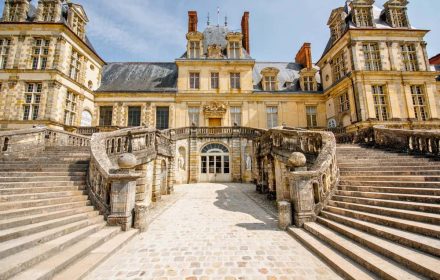This site uses affiliate links, meaning that if you make a purchase through our links, we may earn an affiliate commission.
Rouen is one of those cities that feels like stepping back in time. With its cobbled streets, colorful half-timbered houses, and stunning Gothic architecture, it’s easy to see why it’s known as the “City of a Hundred Spires.” But it’s not just about the looks—Rouen is bursting with history. This is where Joan of Arc faced her trial, where Monet found inspiration for his iconic paintings, and where the past and present come together beautifully.
If you’re planning a trip to Normandy, Rouen should definitely be on your list. And the best way to experience it? On foot. A DIY walking tour of Rouen lets you explore the city at your own pace, discovering hidden gems and iconic spots around every corner.
In this post, we’ll guide you through 17 must-see places, from the majestic Cathédrale Notre-Dame to the charming Aître Saint-Maclou, with a bunch of local gems in between.
- 1. Brief History of Rouen to Set the Stage
- 2. Map of DIY Walking Tour of Rouen
- 3. DIY Walking Tour of Rouen with 17 Best Stops
-
- 3.1. Rue Eau de Robec
- 3.2. Rue Martainville
- 3.3. St. Maclou Catholic Church
- 3.4. Rue Damiette
- 3.5. L'Espiguette
- 3.6. Rue Saint-Romain
- 3.7. Cathédrale Notre-Dame de Rouen
- 3.8. Rue du Gros-Horloge
- 3.9. Le Gros-Horloge
- 3.10. Rue Massacre
- 3.11. Place du Vieux-Marché
- 3.12. Église Sainte-Jeanne-d'Arc
- 3.13. Musée de la Céramique
- 3.14. Donjon de Rouen (Tour Jeanne d'Arc)
- 3.15. Rouen Museum of Fine Arts
- 3.16. Rue Ganterie
- 3.17. Saint-Ouen Abbey Church
- 4. Intrepid's Tips for DIY Walking Tour of Rouen
Brief History of Rouen to Set the Stage
Rouen is a city with a deep and layered history reflected in its streets, buildings, and landmarks. Located on the Seine River, it became the capital of Normandy in the 9th century, and its significance grew over time.
One of the most pivotal moments in Rouen’s history is its role in the trial and execution of Joan of Arc in 1431. After being captured by the English during the Hundred Years’ War, she was tried for heresy in the city. Joan was burned at the stake at Place du Vieux-Marché, where today you’ll find a memorial and a church dedicated to her.
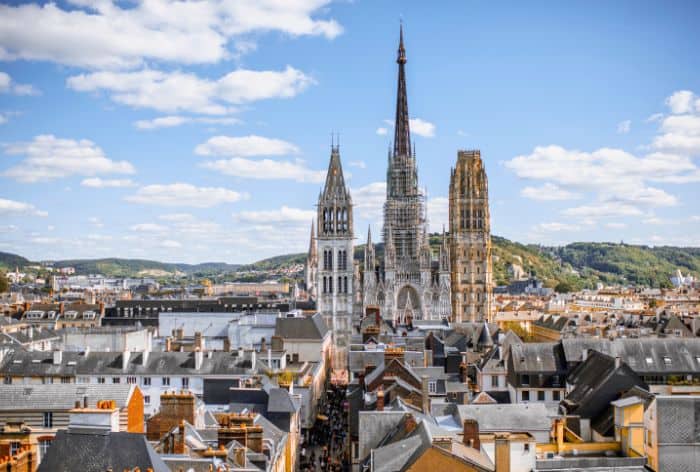
Aerial View of Rouen with Cathédrale Notre-Dame de Rouen in the Distance / DIY Walking Tour of Rouen
Rouen is also home to one of the most famous Gothic cathedrals in France: Cathédrale Notre-Dame de Rouen. This cathedral, with its stunning façade and tallest spire in France, was built between the 12th and 16th centuries. The cathedral’s stained-glass windows are equally impressive, and Claude Monet famously painted a series of its changing appearances in different lighting.
The city’s medieval charm is also visible in its half-timbered houses, many of which date back to the 14th century, and the Gros-Horloge, a 14th-century astronomical clock, is one of Rouen’s iconic landmarks. The clock tower was part of the old city gates and is still operational today, marking the passage of time in the city just as it has for centuries.
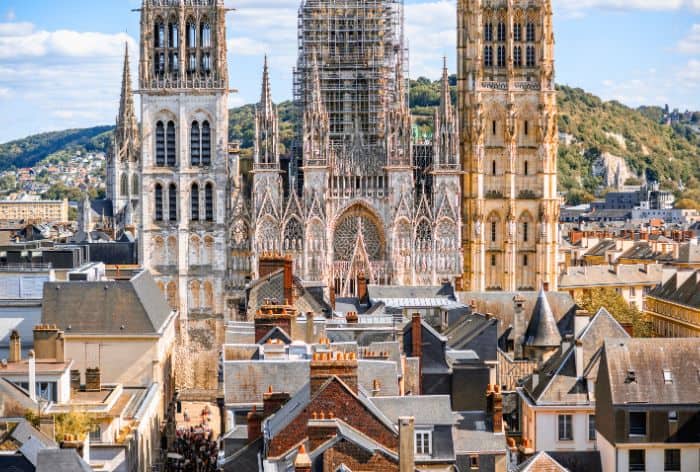
Aerial View of Rouen with Cathédrale Notre-Dame de Rouen in the Distance / DIY Walking Tour of Rouen
In the 16th century, Rouen became a center for trade and culture. It was here that the first French printing press was set up in the early 1500s. During the French Revolution, Rouen witnessed key events, including the execution of royalists and the rise of revolutionary leaders like Maximilien Robespierre.
Rouen’s history is a blend of medieval power, religious significance, artistic influence, and revolutionary change. As you walk through the city, you’ll encounter these layers of history, making it a living museum in its own right.
Map of DIY Walking Tour of Rouen
DIY Walking Tour of Rouen with 17 Best Stops
Rue Eau de Robec
We like to kick off this DIY walking tour of Rouen at Rue Eau de Robec, one of the city’s hidden gems. It’s tucked away from the main tourist spots, which is exactly what makes it so charming.
This street gives you a real taste of Rouen’s medieval vibe, with its colorful half-timbered houses, cobblestone paths, and centuries of history around every corner.
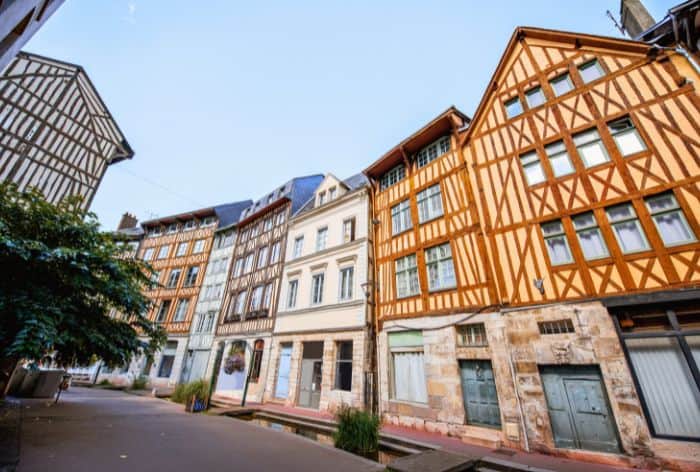
Rue Eau de Robec in Rouen / DIY Walking Tour of Rouen
Rue Eau de Robec gets its name from the Robec, a stream that once ran through here. During the Middle Ages, this was a busy spot for dyers who used the water to rinse their fabrics, creating vibrant colors like deep blues, reds, and purples.
If you’re a fan of Madame Bovary, you might recognize the name—Flaubert mentioned this very stream in his novel, connecting the area to Rouen’s rich literary history.
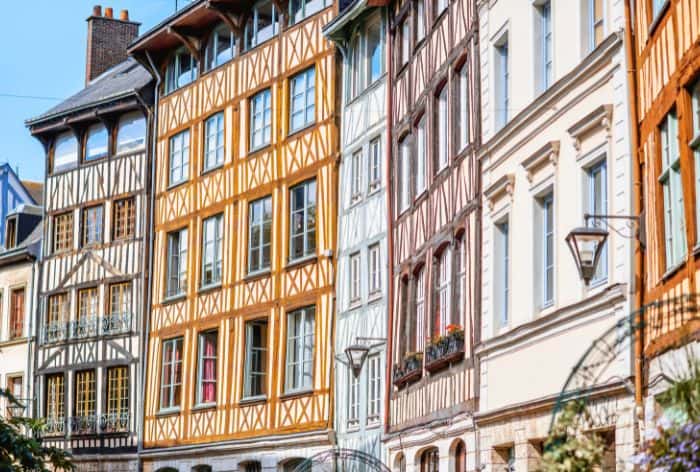
Rue Eau de Robec / DIY Waking Tour of Rouen
PRO TIP: Look up as you walk down the street, and you’ll notice the overhanging attics, known as greniers-étentes. These were once used by textile workers to dry their fabrics and are a cool reminder of Rouen’s industrial past.
Rue Martainville
After exploring Rue Eau de Robec, turn left onto Rue Armand-Carrel and follow it until you reach Rue Martainville, our next stop.
This street is at the heart of the Saint-Maclou district, also known as the Antique district, and is one of the best places to see Rouen’s signature half-timbered houses. Many of these buildings date back to the 15th and 16th centuries, their colorful facades standing in contrast to the cobbled streets.
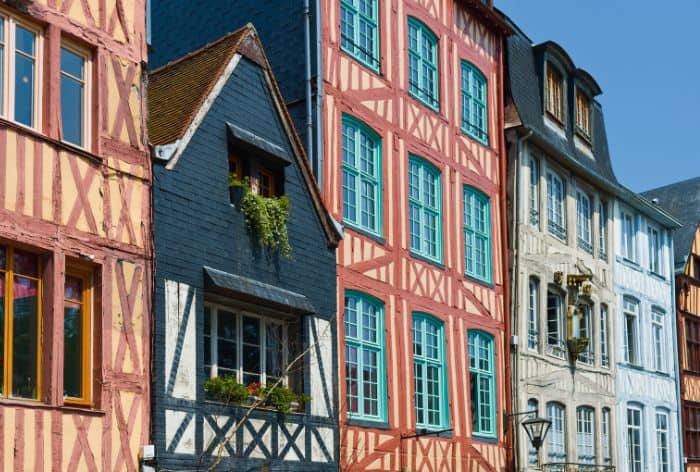
Rue Martainville / DIY Walking Tour of Rouen
GOOD TO KNOW: One of the most eye-catching details here is the leaning house at the corner of Rue Damiette, a quirky architectural feature that’s become a favorite photo spot.
St. Maclou Catholic Church
Leaving Rue Martainville, your next stop is Saint-Maclou Church, one of Rouen’s most remarkable religious landmarks.
This 14th-century church is a masterpiece of Flamboyant Gothic architecture, known for its intricate stonework, towering spires, and elaborate stained-glass windows.
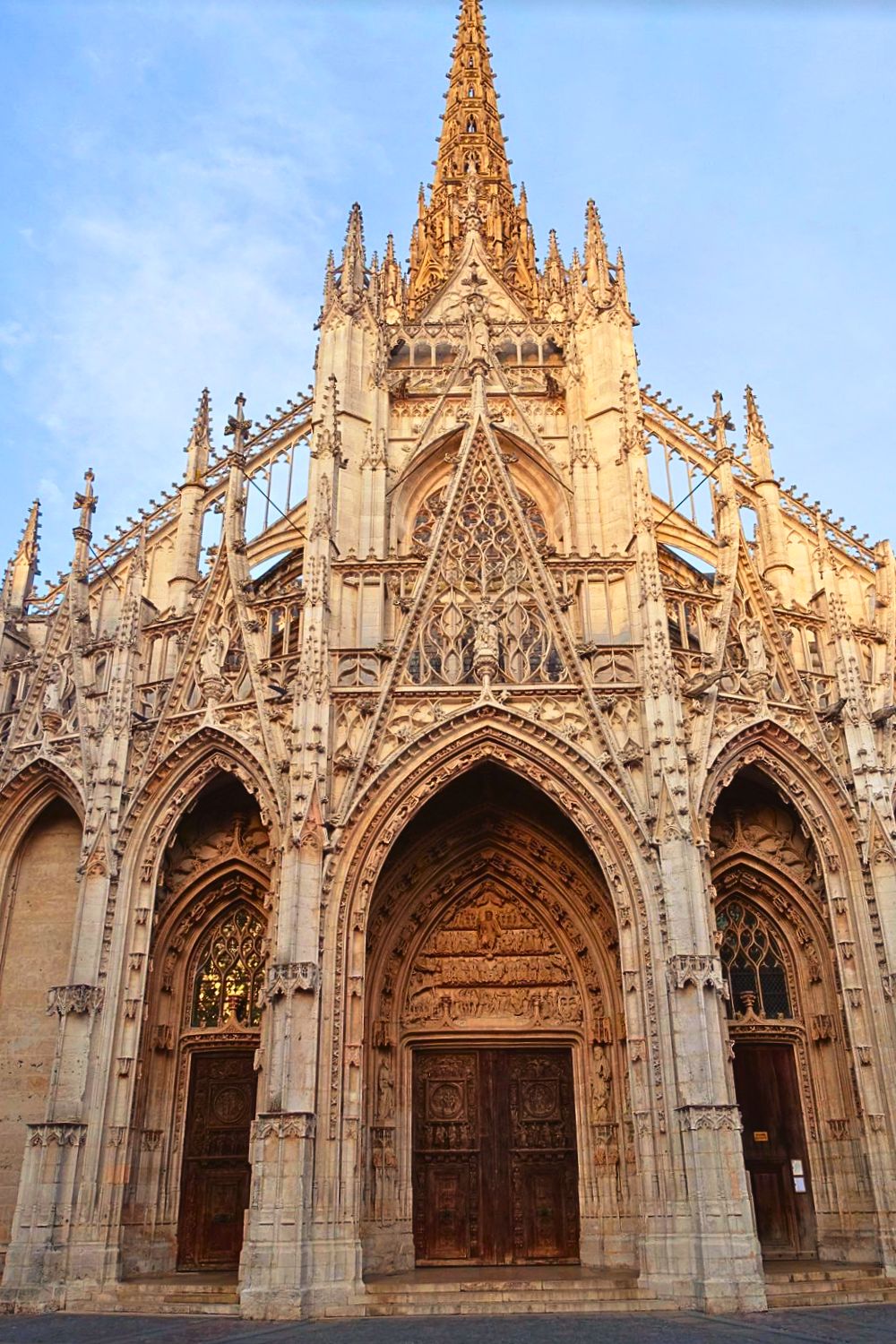
St. Maclou Catholic Church / DIY Walking Tour of Rouen
Dedicated to Saint Maclou, a Breton missionary, the church has undergone several renovations over the centuries, blending different architectural styles.
As you approach, take a moment to admire the intricate carvings on the facade, showcasing the exceptional craftsmanship of the period. The rose window, a stunning circular stained-glass piece, filters light into the church, creating a breathtaking display inside.
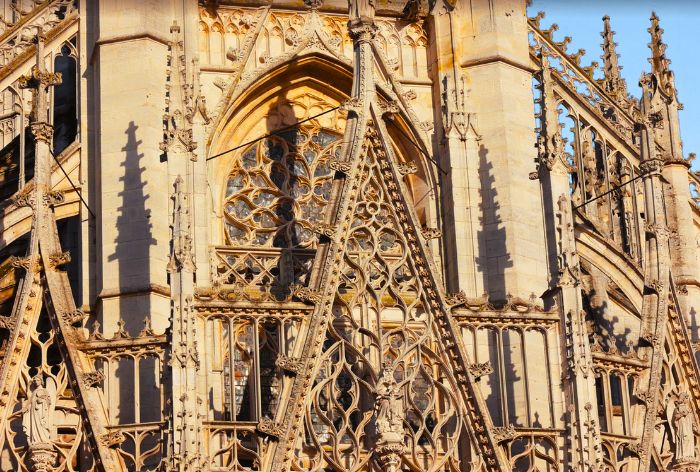
St. Maclou Catholic Church / DIY Walking Tour of Rouen
Step inside to experience the peaceful atmosphere. The high vaulted ceilings and slender columns add to the grandeur, while the stained-glass windows depict biblical stories in striking color and detail.
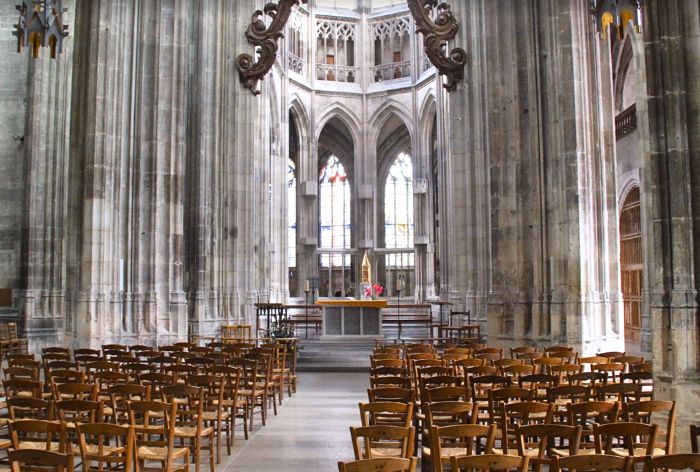
St. Maclou Catholic Church / DIY Walking Tour of Rouen
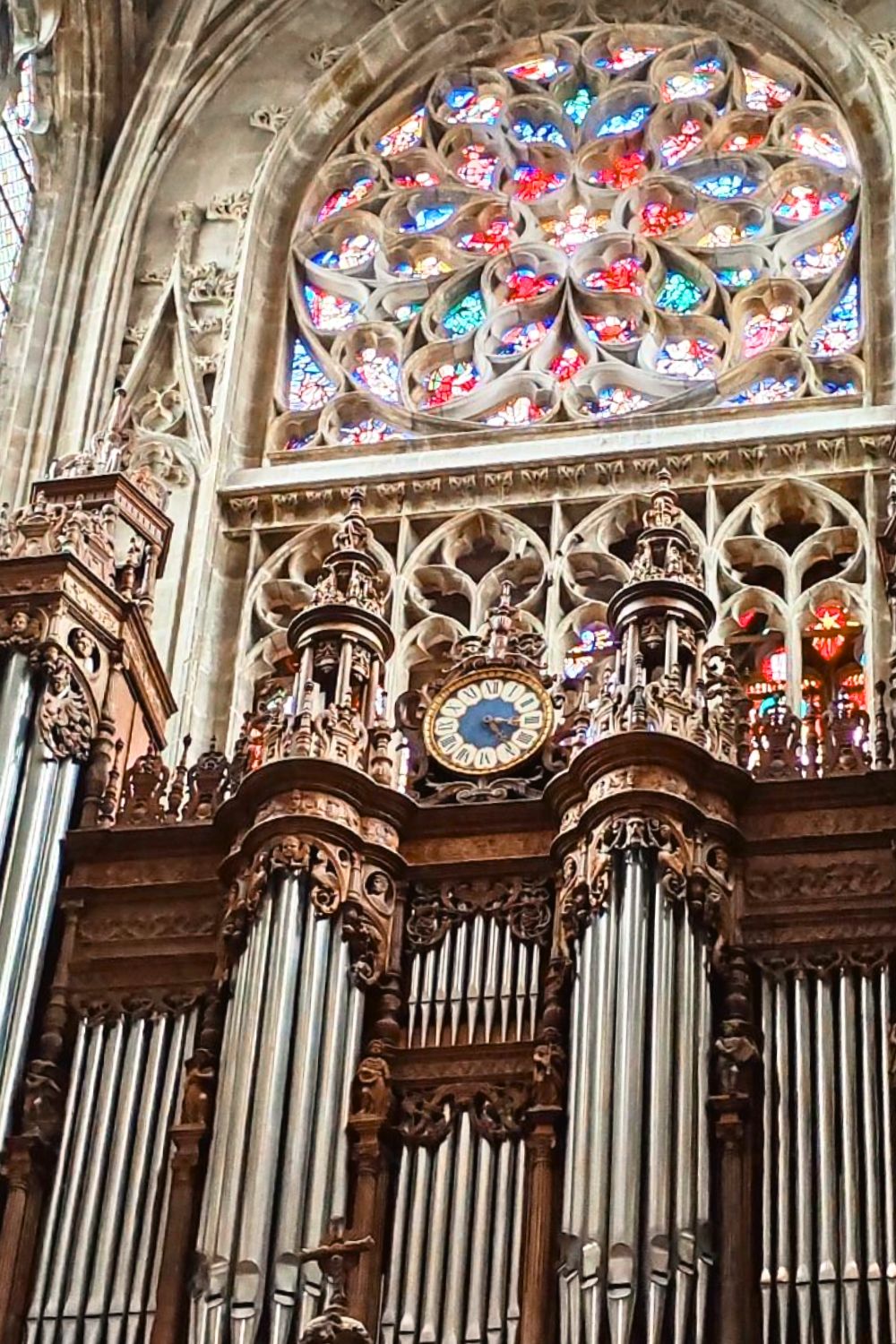
St. Maclou Catholic Church / DIY Walking Tour of Rouen
GOOD TO KNOW: The entrance is free of charge. Opening hours are Saturday and Sunday 10 am till 12 pm and 2 pm till 5 pm.
Rue Damiette
From Saint-Maclou Church, continue onto Rue Damiette, one of Rouen’s most picturesque streets. Lined with well-preserved half-timbered houses, this historic street is best known for its concentration of antique shops. Many of these shops are filled with vintage furniture, rare books, and unique artifacts.
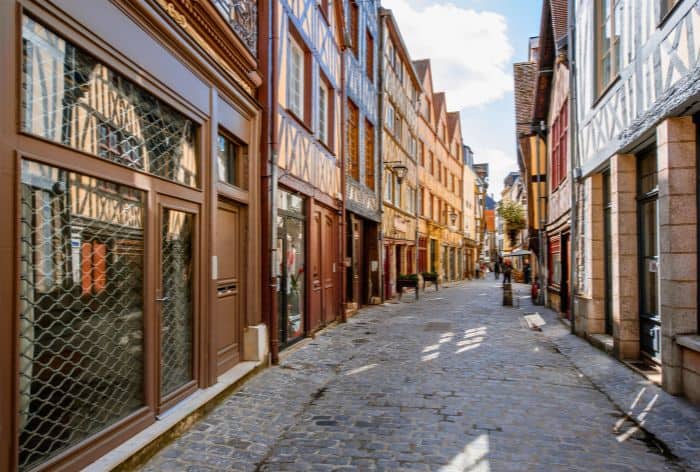
Rue Damiette / DIY Walking Tour of Rouen
Beyond antiques, Rue Damiette is also home to art galleries, boutique shops, and traditional craft workshops, including violin makers who continue Rouen’s long tradition of fine craftsmanship.
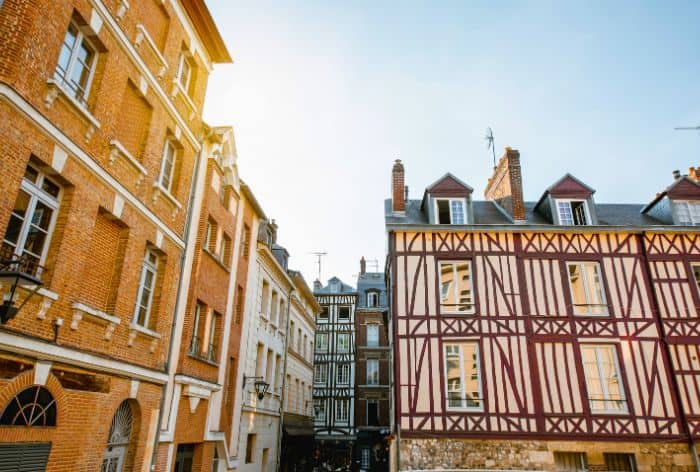
Rue Damiette / DIY Walking Tour of Rouen
GOOD TO KNOW: In 1884, impressionist painter Camille Pissarro sketched Rue Damiette, capturing its unique atmosphere. Walking down this street today, you’re seeing the same charming views that inspired him over a century ago.
L'Espiguette
After exploring Rue Damiette, it is time to take a break at L’Espiguette, a cozy, no-frills bistro that serves some of the best traditional French dishes in town.
My go-to? The Osso Buco—slow-cooked veal so tender it practically melts, bathed in a rich, savory sauce. If you’re feeling like something different, the Veal Andouillette with Mustard Cream packs a bold, rustic flavor. Either one is a perfect mid-tour meal before heading to the next stop.
Rue Saint-Romain
Once you’ve finished your meal at L’Espiguette, it’s time to head to Rue Saint-Romain, one of the most historic and picturesque streets in Rouen.
To get there, turn right onto Rue Saint-Amand and continue to Rue des Chanoines, a historic street once home to cathedral clergy. Next, make a slight right on Rue St. Nicolas and another right onto Rue Saint-Romain (follow my map!).
Rue Saint-Romain is lined with beautifully preserved half-timbered houses, some dating back to the 15th and 16th centuries, this street offers a glimpse into the city’s medieval past. Many of these buildings once housed merchants and craftsmen.
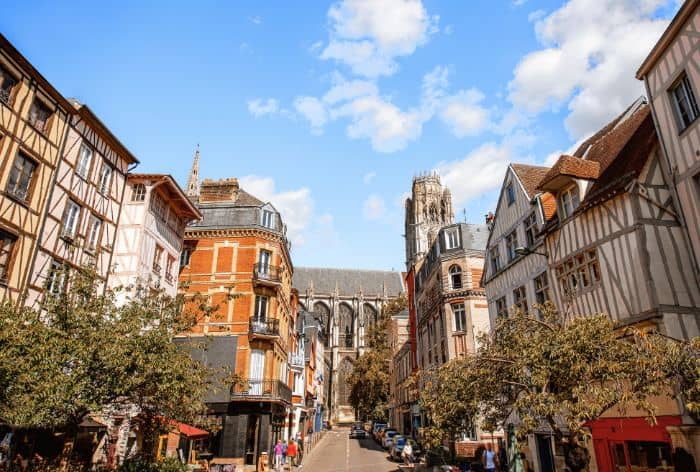
Rue Saint-Romain / DIY Walking Tour of Rouen
The street leads directly to Cathédrale Notre-Dame de Rouen, offering stunning views of its towering Gothic facade. This close connection to the cathedral made Rue Saint-Romain an important route for clergy and pilgrims in centuries past. Today, you can still see remnants of this religious heritage, including the Archbishop’s Palace, which stands along the street.
Cathédrale Notre-Dame de Rouen
After soaking in the charm of Rue Saint-Romain, it’s time to visit Cathédrale Notre-Dame de Rouen, the city’s most iconic landmark. This Gothic masterpiece has stood at the heart of Rouen for centuries, and once you lay eyes on it, you’ll see why it’s such a key part of the city’s history.
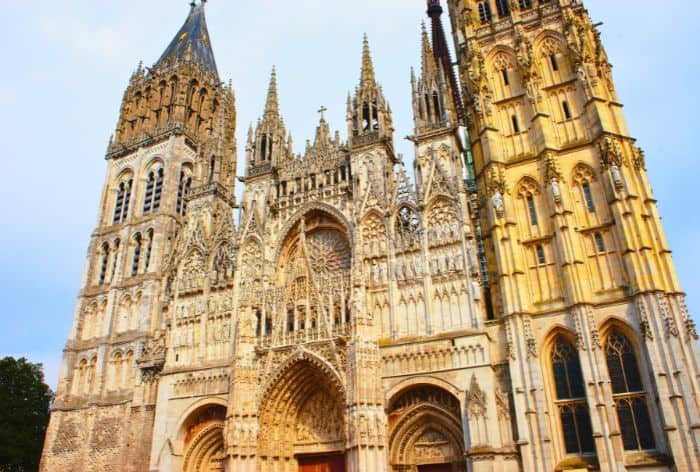
Cathédrale Notre-Dame de Rouen / DIY Walking Tour of Rouen
Construction started in the 12th century, though the cathedral is built on top of even older foundations—a 4th-century basilica and an 11th-century Romanesque church. Over time, the cathedral grew and changed, blending styles across centuries. Its Gothic facade is particularly stunning, and each tower represents a different architectural style.
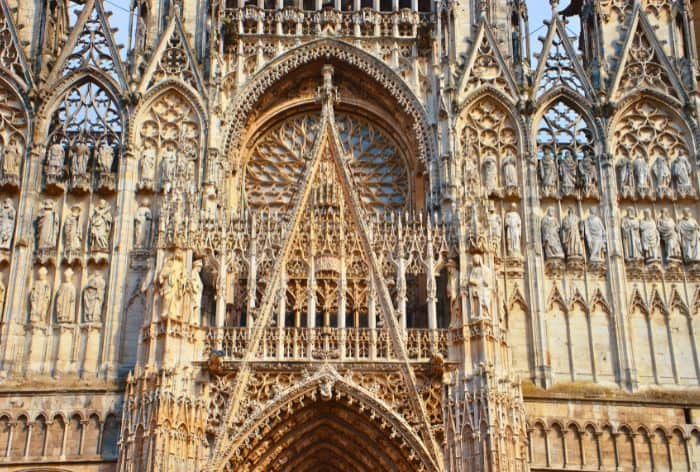
Cathédrale Notre-Dame de Rouen / DYI Walking Tour of Rouen
Monet was so taken by the cathedral that he painted it multiple times, capturing how the light changes on the stone throughout the day.
The facade alone is worth a visit, but inside, you’ll find the tombs of notable figures, including Richard the Lionheart’s heart. The stained glass windows are breathtaking!
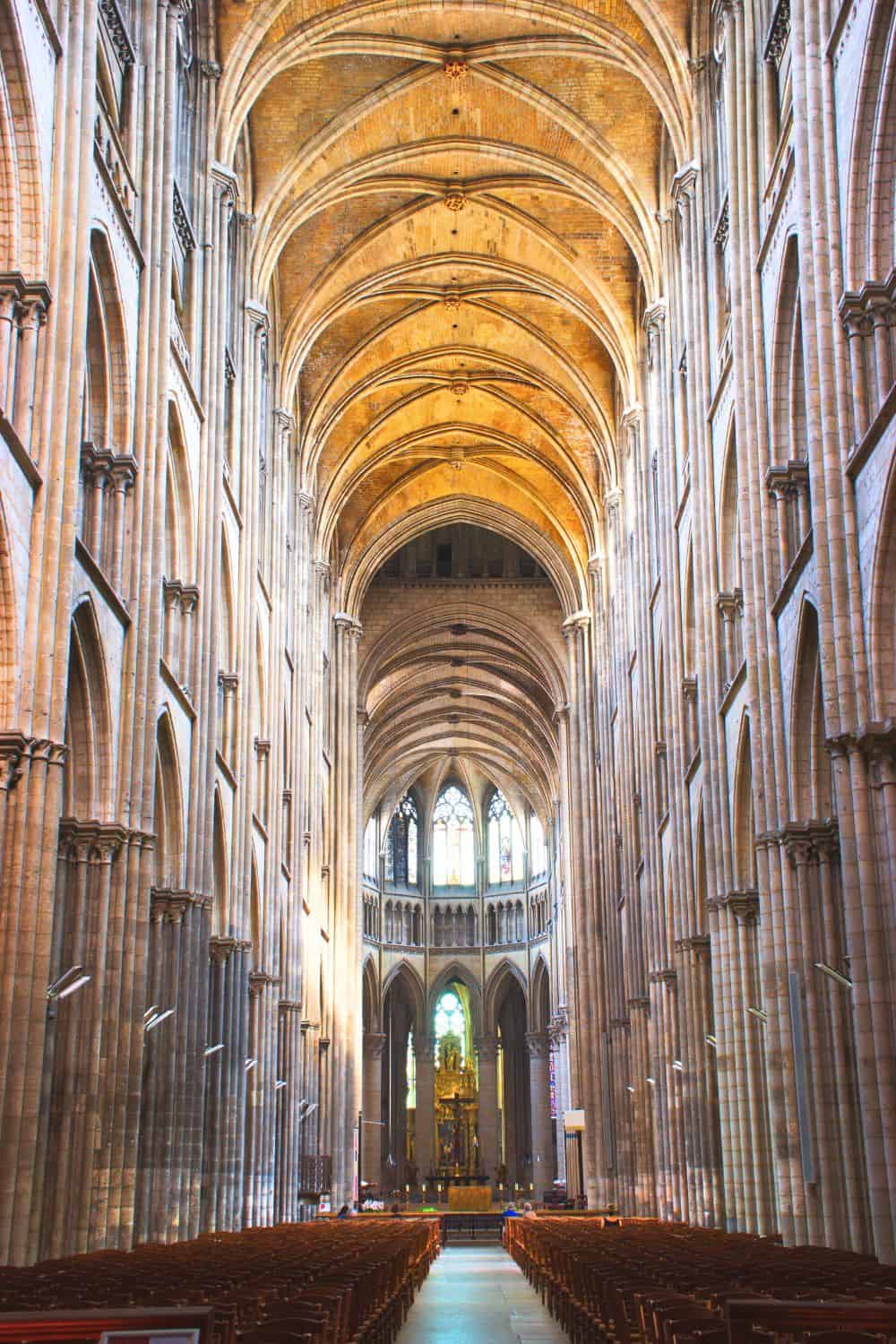
Cathédrale Notre-Dame de Rouen / DIY Walking Tour of Rouen
GOOD TO KNOW: Entry to the cathedral is free, but if you’d like to visit the crypt or baptistery chapel, there’s a small fee of €2. You can also book a guided tour or rent an audio guide to learn more about its fascinating history.
The opening hours are: Monday: 2:00 pm – 6:00 pm, Tuesday to Saturday: 9:00 am – 12:00 pm and 2:00 pm – 6:00 pm, Sunday and Public Holidays: 8:00 am – 6:00 pm.
PRO TIP: If you’re visiting in the summer, don’t miss the Cathédrale de Lumière light show. This free event runs nightly from late May to late September and features stunning projections that bring the cathedral’s facade to life in vibrant colors.
Rue du Gros-Horloge
Next, head down Rue du Gros-Horloge. It is a pedestrian street that sits at the heart of Rouen’s historic center and connects Cathédrale Notre-Dame to Place du Vieux-Marché.
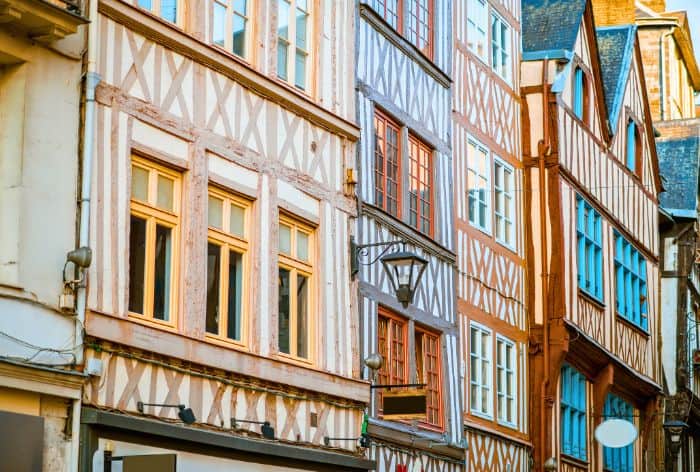
Rue du Gros Horloge in Rouen / DIY Walking Tour of Rouen
As you walk, you’ll be surrounded by beautifully preserved half-timbered houses that transport you to the medieval era. The street is filled with shops, and cafes.
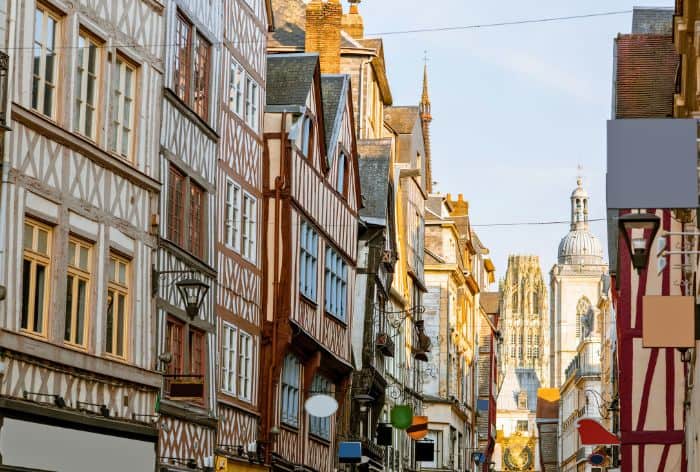
Rue du Gros Horloge in Rouen / DIY Walking Tour of Rouen
Keep walking, and you’ll soon come face-to-face with one of the city’s most iconic landmarks: the Gros-Horloge.
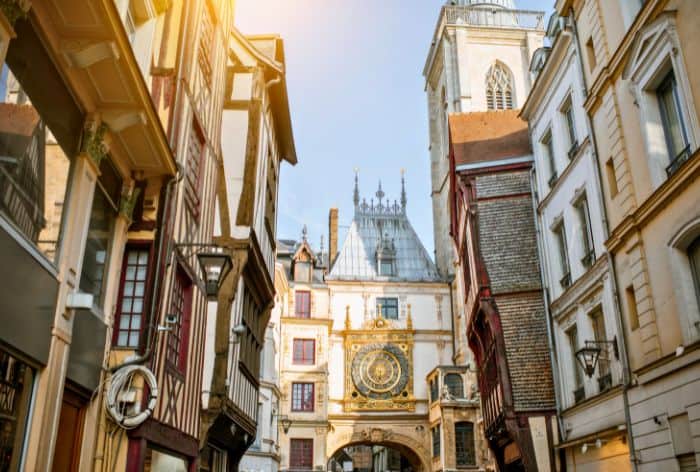
Rue du Gros Horloge in Rouen / DIY Walking Tour of Rouen
Le Gros-Horloge
The Gros-Horloge is a 14th-century astronomical clock housed in an impressive Renaissance archway. It is one of the oldest working clocks in Europe. What sets it apart is its single hand—a feature designed back in the day to keep things simple and effective.
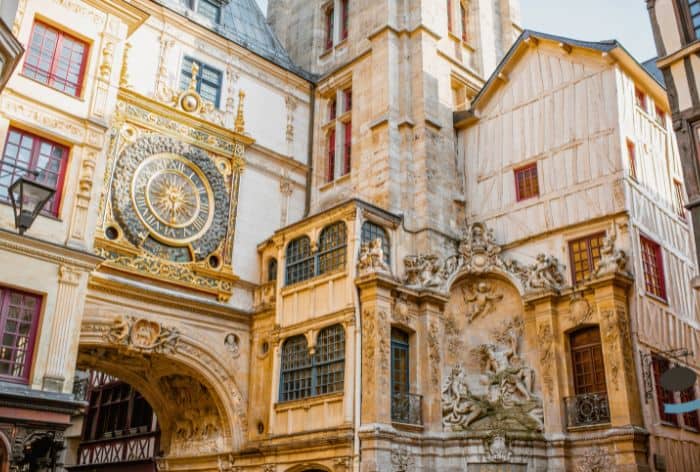
Le Gros Horloge / DIY Walking Tour of Rouen
The clock’s golden sun rays and the deep blue, starry background, make it truly stand out.
The clock’s mechanism is a marvel of medieval craftsmanship, still ticking after over 600 years of operation.
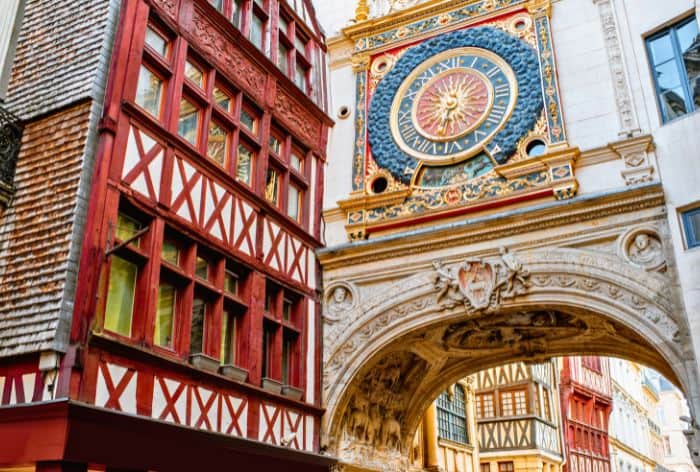
Le Gros Horloge / DIY Walking Tour of Rouen
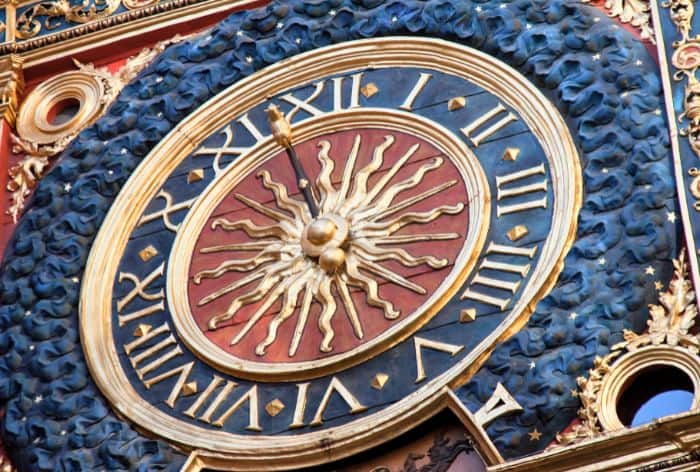
Le Gros Horloge / DIY Walking Tour of Rouen
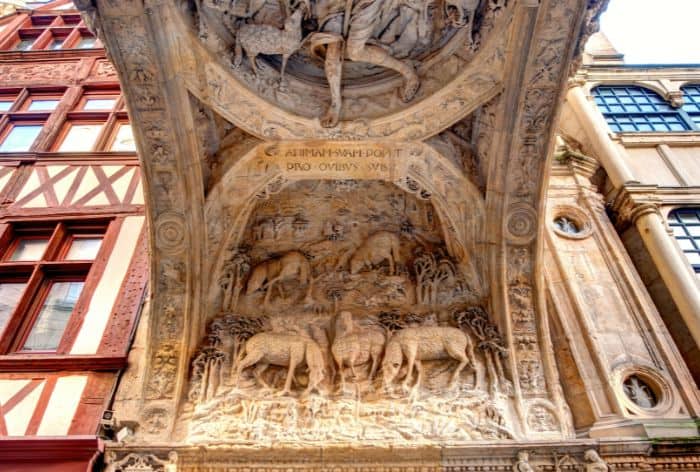
Le Gros Horloge / DIY Walking Tour of Rouen
PRO TIP: Consider visiting the Gros-Horloge Museum. There, you can get a closer look at the clock’s mechanics and enjoy panoramic views of Rouen from the belfry. For opening hours and admission prices click here.
Rue Massacre
After soaking in the beauty of Le Gros-Horloge, take Rue Massacre. Don’t worry, the name isn’t as grim as it sounds! Back in the day, this street was home to the city’s butchers, hence the name “Rue des Boucheries Massacres.”
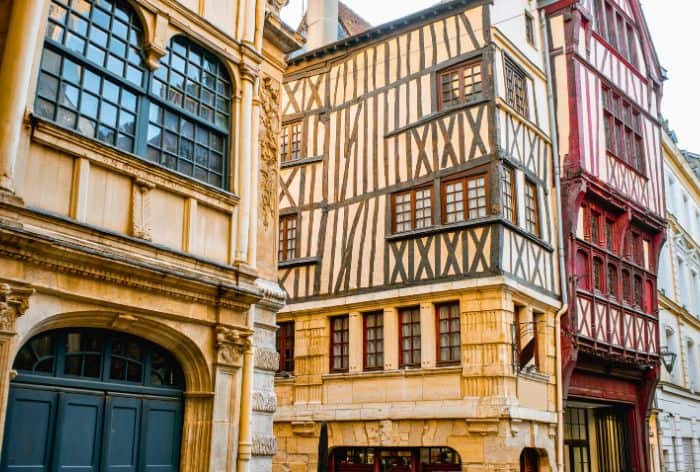
Rue Massacre / DIY Walking Tour of Rouen
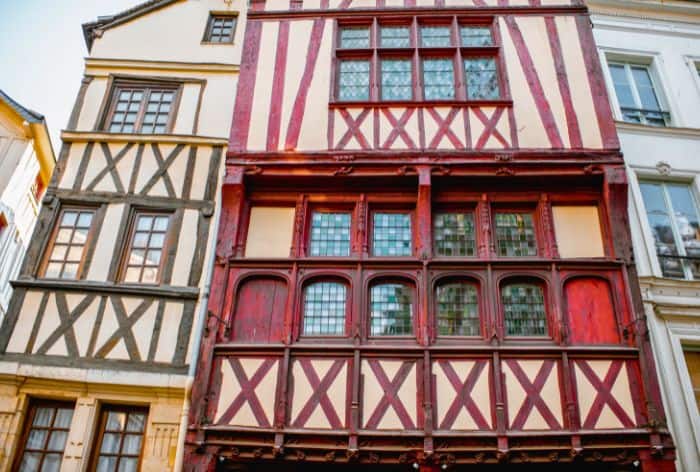
Rue Massacre / DIY Walking Tour of Rouen
GOOD TO KNOW: Rue Massacre is an Instagram favorite, and for a good reason. The street really comes to life during the holiday season when it’s decked out in stunning decorations. Think colorful umbrellas floating above, oversized bows, and artistic frames that make every corner pop with charm.
Place du Vieux-Marché
Your next stop is Place du Vieux-Marché, a square deeply tied to Rouen’s history. This is the exact location where Joan of Arc was burned at the stake on May 30, 1431, condemned as a heretic by an English-backed court during the Hundred Years’ War. A large cross marks the execution site, serving as a memorial to France’s national heroine.
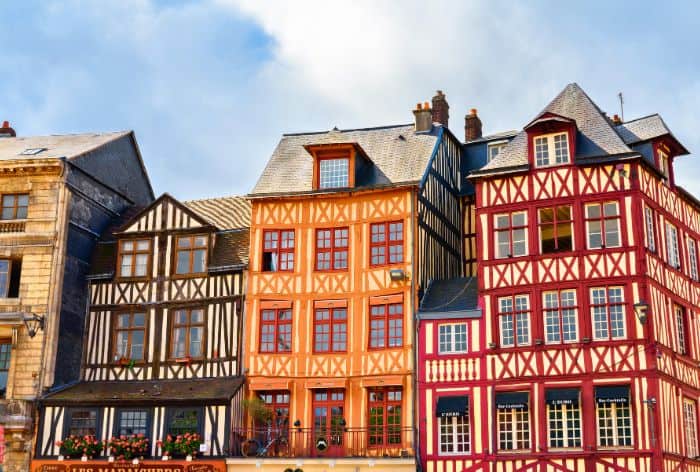
Place du Vieux-Marché / DIY Walking Tour of Rouen
Despite its somber past, Place du Vieux-Marché is now a vibrant hub lined with half-timbered houses, giving it that classic medieval charm.
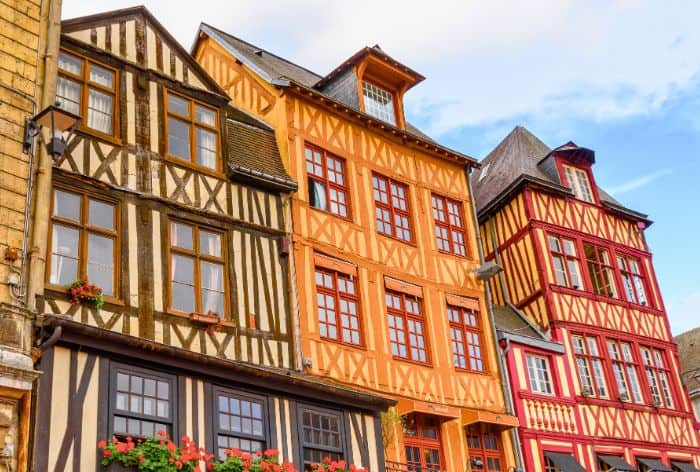
Place du Vieux-Marché / DIY Walking Tour of Rouen
The square is also home to the Church of Saint Joan of Arc, built in 1979, which is next on our DIY walking tour of Rouen.
Église Sainte-Jeanne-d'Arc
Next, make your way to Église Sainte-Jeanne-d’Arc, the modern church dedicated to Joan of Arc.
This isn’t your typical old church; it was built between 1975 and 1979, right on the very spot where Joan of Arc was martyred.
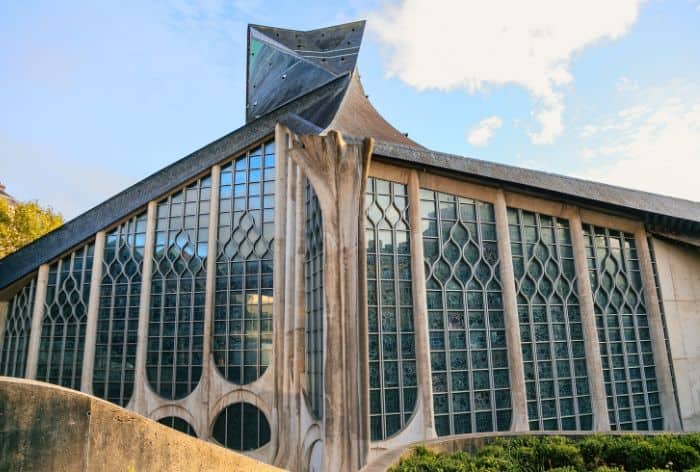
Église Sainte-Jeanne-d’Arc / DIY Walking Tour of Rouen
The design of the church is pretty unique too. It may look modern from the outside, but once you step inside, you’ll find stunning stained-glass windows from the original Church of Saint Vincent, which was destroyed during World War II.
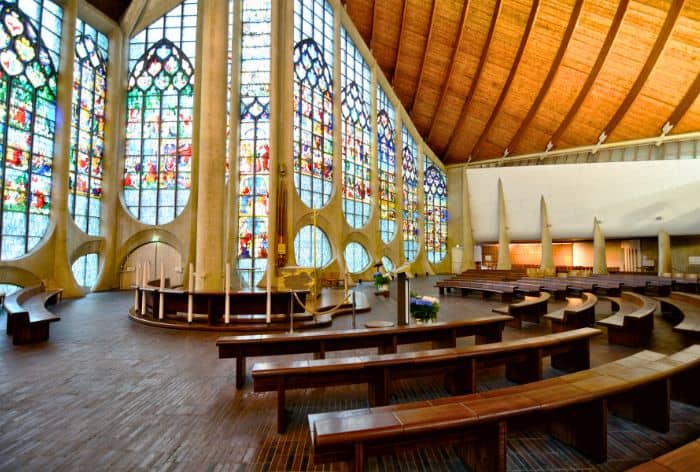
Église Sainte-Jeanne-d’Arc / DIY Walking Tour of Rouen
GOOD TO KNOW: There’s no entrance fee. It’s open from Friday to Sunday, from 10 am to 12 pm, and again from 2 pm to 5 pm.
Musée de la Céramique
If you have extra time and want to dive into Rouen’s artistic heritage, visit the Musée de la Céramique.
This museum houses over 5,000 pieces of ceramic art, highlighting the city’s importance in pottery from the 16th to 18th centuries.
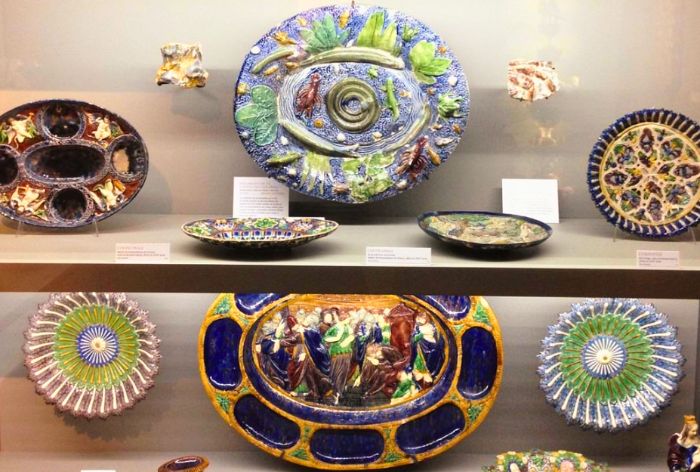
Musée de la Céramique / DIY Walking Tour of Rouen
The collection includes earthenware and porcelain from Rouen’s golden age of ceramics, along with pieces from renowned pottery centers like Sèvres, Delft, and Nevers. You’ll also see exquisite rococo and chinoiserie-inspired designs on plates, vases, and figurines.
GOOD TO KNOW: Admission is free and the museum is open daily from 2 pm till 6 pm.
Donjon de Rouen (Tour Jeanne d'Arc)
Your next stop is the Donjon de Rouen, also known as the Tour Jeanne d’Arc. This is the only remaining part of the Château de Rouen, a fortress built by King Philippe Auguste in the 13th century to strengthen the city’s defenses.
While much of the castle is gone, this cylindrical stone tower stands as a reminder of Rouen’s medieval past.
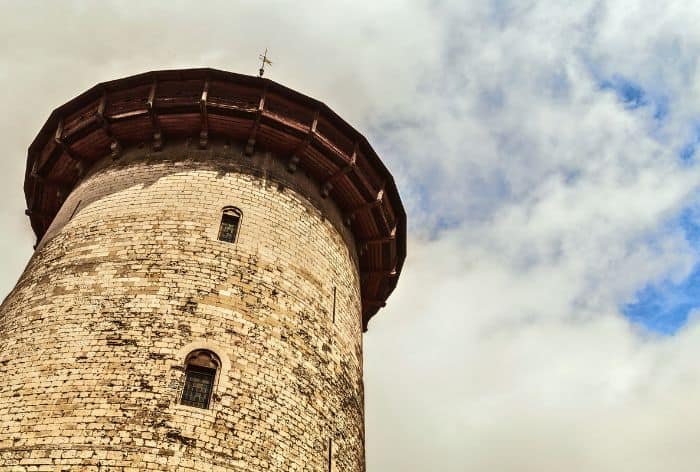
Donjon de Rouen / DIY Walking Tour of Rouen
The Donjon is most famous for its connection to Joan of Arc, who was imprisoned here in 1431 before her trial. Though she was not sentenced here, the tower is a powerful symbol of her story and the turbulent history of Rouen.
Inside you will be able to learn about the original castle and its construction and find out about Joan of Arc, her imprisonment, trial, and legacy.
For opening hours and admission prices click here.
Rouen Museum of Fine Arts
If you enjoy art and history, the Rouen Museum of Fine Arts is a must-see! It boasts an impressive collection of paintings, sculptures, and decorative arts spanning several centuries.
Highlights include works by Monet, Delacroix, Caravaggio, and Velázquez. The museum also features a sculpture garden, a quiet spot to unwind amidst beautiful artwork.
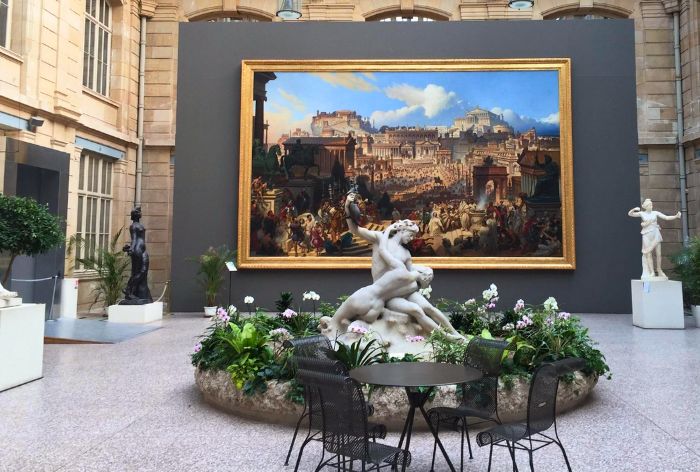
Rouen Museum of Fine Arts / DIY Walking Tour of Rouen
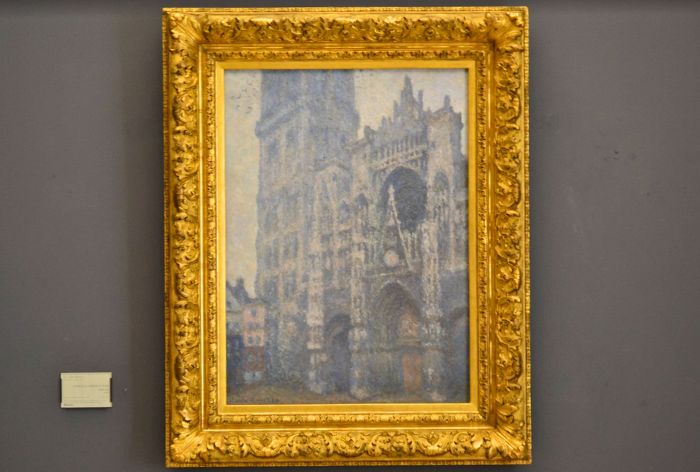
Rouen Museum of Fine Arts / DIY Walking Tour of Rouen
For opening times and entrance fees click here.
PRO TIP: Short on time? Feel free to skip it. But if you’re an art lover, this museum is one of France’s best outside Paris and well worth a stop.
Rue Ganterie
Next, take Rue Ganterie.
This historic street in the heart of Rouen was once the center of the city’s glove-making industry, which thrived here in the Middle Ages. The name “Ganterie” comes from the French word for gloves, a trade that played a major role in Rouen’s economy.
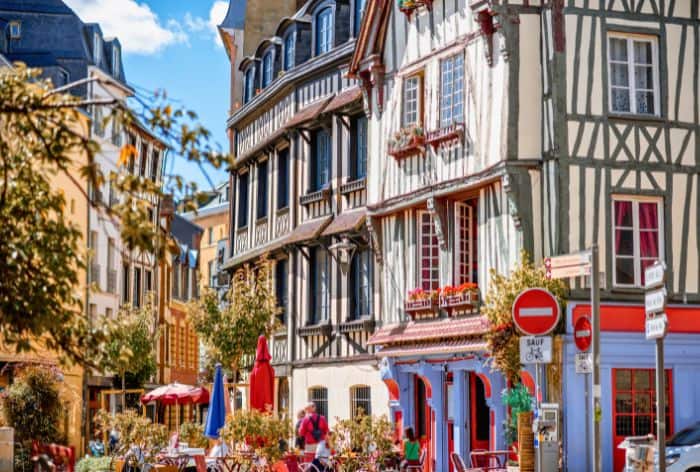
Rue Ganterie / DIY Walking Tour of Rouen
Lined with well-preserved half-timbered houses, Rue Ganterie is a perfect example of medieval architecture. These maisons à colombages date back centuries, their exposed wooden beams and colorful facades offering a glimpse into Rouen’s past.
Saint-Ouen Abbey Church
Next, make your way to Saint-Ouen Abbey Church, it is our final stop on this DIY walking tour of Rouen.
Saint-Ouen Abbey Church is one of Rouen’s greatest Gothic landmarks. Built between the 14th and 16th centuries, this massive church was once part of a powerful Benedictine abbey. Its sheer scale and intricate stonework make it a masterpiece of Rayonnant Gothic architecture, rivaling even the Notre-Dame Cathedral.
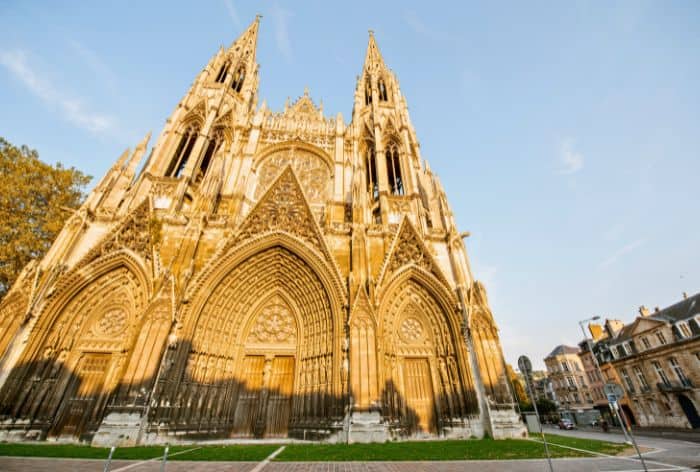
Saint-Ouen Abbey Church in Rouen / DIY Walking Tour of Rouen
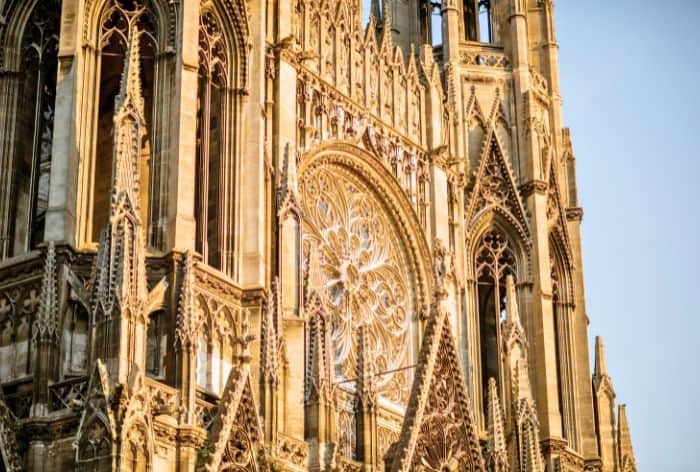
Saint-Ouen Abbey Church in Rouen / DIY Walking Tour of Rouen
Inside, the soaring vaulted ceiling and slender columns create a breathtaking sense of space. The stained glass windows, dating from the 15th and 16th centuries, bathe the interior in colorful light.
At the church’s center, a lantern tower rises above the crossing, a rare feature in French Gothic churches, reminiscent of England’s Ely Cathedral.
One of its most prized features is the Cavaillé-Coll organ, built in 1890. It is considered one of the finest Romantic organs in France, and if you’re lucky enough to hear it played, the sound is unforgettable.
GOOD TO KNOW: Saint-Ouen Abbey Church is free to enter, however, it is only open on Saturdays and Sundays from 10 am to 12 pm and from 2 pm to 5 pm.
Intrepid's Tips for DIY Walking Tour of Rouen
This walking tour covers a lot of ground, and you might not have time to see everything. No worries! If you’re short on time, here are the top spots you shouldn’t miss:
- Notre-Dame Cathedral – Start your journey at this Gothic masterpiece. Its intricate facade, towering spires, and stunning stained glass windows make it an essential stop.
- Place du Vieux-Marché – The historic square where Joan of Arc was martyred. Today, it’s home to the modern Church of Saint Joan of Arc, an architectural contrast worth seeing.
- Rue du Gros-Horloge – Walk this lively street to see the Gros-Horloge, one of Europe’s oldest working astronomical clocks. Its intricate golden details and Renaissance archway are a must-see.
- Saint-Ouen Abbey Church – End your tour at this stunning Gothic church, known for its soaring vaults, remarkable stained glass, and historic organ.
PRO TIP: We didn’t do a DIY walking tour on our first visit to Rouen, and that was fine. If you’d rather skip the planning, we recommend joining a guided tour. It takes the stress off, and you’ll get insider stories and hidden gems from a knowledgeable guide. One tour we enjoyed was – Small Group Guided Tour of the Secret History of Rouen – relaxed, informative, and a great way to see the city without worrying about missing anything.
Here Are Some More Ideas of Places to Visit in France:
Did You Find DYI Walking Tour of Rouen Useful?
Why Not Save It to Your Pinterest Board!


Now, It Is Your Turn, I Would Like to Hear Back from You!
Are you planning your trip to France?
Please let me know!
Drop me a quick comment right below!
Click on any of the images below to get inspired!
